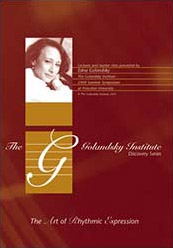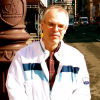Home » Jazz Articles » Film Review » Edna Golandsky: The Art of Rhythmic Expression
Edna Golandsky: The Art of Rhythmic Expression
 Edna Golandsky
Edna Golandsky The Art of Rhythmic Expression
The Golandsky Institute
2005
The Art of Rhythmic Expression is a three-DVD set featuring lectures given by Edna Golandsky at Princeton University in the summer of 2004. The lectures represent the next chapter in the presentation of the Taubman approach to piano performance. In a previously released 10-volume video set from the Taubman Institute, Golandsky presented the foundational principles of the Taubman approach and showed how well suited the recorded video medium is to the communication of principles that form a physiologically optimal technique.
The superb technical production quality of The Art of Rhythmic Expression has greatly enhanced the effectiveness of the presentation and sets a high standard for visual clarity in an instructional video. Demonstrations at the piano are filmed from multiple camera angles, sometimes allowing the viewer to watch in split screen format from four different perspectives: right, left, above and close-up. Nuanced movement as the forearm moves the hand forward and slightly higher, creating the curvilinear shaping of phrases, is captured by the cameras, giving the viewer the best possible opportunity to observe each motion and to hear the musical result.
Professional jazz pianists and educators may be particularly interested in the focus on rhythm in the Golandsky lectures. In the hierarchy of important musical elements of a jazz performance, musicians routinely place "feel" at the top. The highest level of musical experience can occur when the music feels great, swings hard, has a deep groove, is heavily in the pocket, cooks or burns. The rhythmic complexity of jazz, with its endless subdivisions of the beat, polyrhythms, shifting accents, and dynamic nuance, makes rhythmic "feel" perhaps the most difficult aspect of the idiom to teach. The approach most often used is to have the student engage in saturation listening to develop an understanding of jazz rhythm through osmosis. This is an indispensable part of the process because it forms the concept and rhythmic intent of the improvising musician. However, it doesn't address the issue of translating the intent into a musical result at the keyboard.
This is precisely the issue addressed by Golandsky. Indeed, the great accomplishment of the Taubman approach in general is the realization of musical intent through the most efficient physical motions. Using pieces from the classical repertoire, Golandsky demonstrates how rhythmic vitality, flow and swing can be achieved through shaping, tone production and the emphasis of beats, revealing how physical movements relate to the rhythmic construction of each phrase. The application of this information for jazz pianists seems evident. When transcribing a great jazz solo, musicians are often confronted with the difficulty of notating a melodic line. Note placement may range from on top of the beat to "laid back" (behind the beat), with ghosted notes and shifting accents in unpredictable places. This all adds to the momentum of the music and offers technical challenges for the pianist. The Art of Rhythmic Expression provides a greater understanding of how to use the playing mechanism (fingers, hands, and forearms) to more easily execute the rhythmic language of jazz, and to enliven the rhythmic foundation of piano playing in any idiom.
The Golandsky Institute has contributed an important and innovative work with the release of this three disc set. Edna Golandsky gives a fresh perspective on the development of rhythmic piano performance and continues to explore a new paradigm in piano pedagogy. Not to be overlooked is the enjoyment of hearing Golandsky perform extended excerpts from the musical examples provided with the DVDs. Her pianism is extraordinary...and she swings!
Recorded: July, 2004 at McCormick Hall, Princeton University. Extras: reference score of musical examples.
< Previous
Mark F. Turner's Best Of 2009
Next >
Upstream
Comments
Tags
For the Love of Jazz
 All About Jazz has been a pillar of jazz since 1995, championing it as an art form and, more importantly, supporting the musicians who create it. Our enduring commitment has made "AAJ" one of the most culturally important websites of its kind, read by hundreds of thousands of fans, musicians and industry figures every month.
All About Jazz has been a pillar of jazz since 1995, championing it as an art form and, more importantly, supporting the musicians who create it. Our enduring commitment has made "AAJ" one of the most culturally important websites of its kind, read by hundreds of thousands of fans, musicians and industry figures every month.






















